When I look at a snapping turtle, I see Proganochelys, one of the first complete turtle fossils from the Triassic Period, nearly 300 million years ago
When I look at a snapping turtle, I see Proganochelys, one of the first complete turtle fossils from the Triassic Period, nearly 300 million years ago. Although long extinct, Proganochelys resembled today’s snapping turtles and had a long, armored tail and a large head on an extended neck, clearly illustrating a well-designed body plan that has survived the ages.
Snapping Turtle Information
North American Alligator Snapping Turtle is Actually Three Different Species
The common snapping turtle (Chelydra serpentina) and alligator snapping turtle (Macrochelys temminckii) are the only two extant members of the family Chelydridae, which is confined to North America, as well as Mexico. Some turtle taxonomists consider the big-headed turtle (Platysternon megacephalum) from Southeast Asia to be a distant relative, although various genetic studies have debated that speculation and the true relationship is currently unresolved.

Kurt Buhlman
The author in 1974 with the first common snapper he ever captured.
A large adult common snapper can weigh up to 40 pounds, but an alligator snapper, being one of the world’s heaviest freshwater turtles, can often weigh between 70 and 200 pounds, with records for males exceeding 300 pounds. (Competition in the weight category comes from the South American Amazon River turtle, Podocnemis expansa, which maxes out at about 200 pounds, and the nearly extinct South Asian Yangtze giant softshell, Rafetus swinhoei, reported to possibly reach 440 pounds.) Male snappers often reach larger sizes than females, but the two sexes are otherwise indistinguishable except that the cloaca of adult males extends beyond the edge of the carapace.
Snappers, of course, derive their common name from their tendency to snap or strike defensively when they feel threatened, and they are indeed capable of delivering a serious bite.
Common Snappers
Common snapping turtles occur throughout much of eastern North America, from Florida up to Ontario and Quebec and westward to Kansas and south to Central America. Up to four subspecies have been recognized, with two in Central America and the “common” snapping turtle (C. s. serpentina) occurring in the eastern U.S. and the Florida snapping turtle (C. s. osceola) confined to the Florida peninsula. The described differences in appearance between the two U.S. subspecies are subtle, with spines on the neck being slightly pointed in the Florida subspecies or more rounded and wart-like in the “common” subspecies. It has been recently debated whether the Florida snapping turtle is a distinct subspecies.
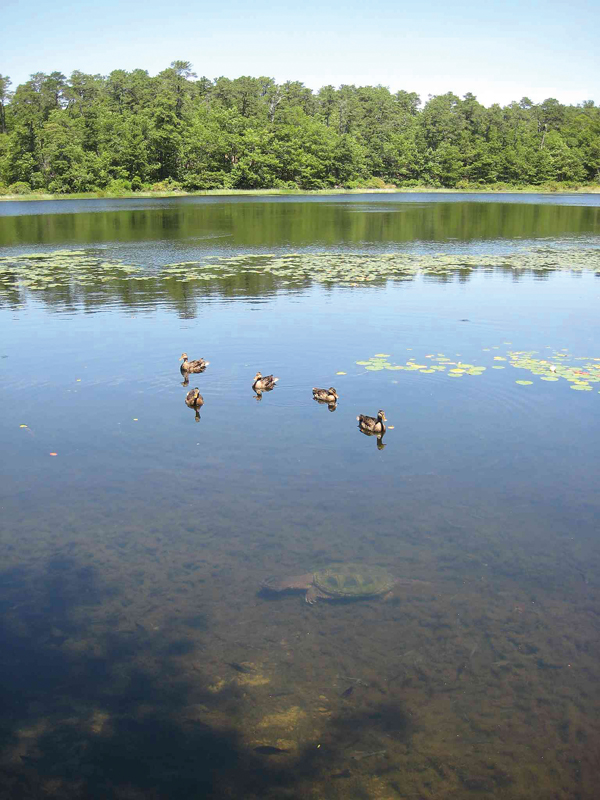
kurt buhlman
At a Cape Cod lake, the author observed that the common snapper visible in the water at the bottom of this photo showed no interest in the ducks paddling above it.
Common snapping turtles are ubiquitous in most freshwater habitats including lakes, ponds, marshes, swamps and slow-moving streams and rivers. Adults have been known to wander into brackish/salt-marsh habitats, although how long they remain is unknown. Common snappers are known to travel surprising distances over land, and will occasionally bury themselves and aestivate for extended periods. Female common snappers are often encountered crossing roads during the nesting season of May and June, and are sometimes killed on highways.
The carapace of the common snapping turtles is drab brown or greenish—textured in young animals but smooth in older turtles—and the rear edge is deeply serrated. The plastron is greatly reduced in size and provides minimal protection. Perhaps this is what snappers make up for with their aggressive attitudes.
The Alligator Snapper
Alligator snapping turtles, in contrast to their “common” brethren, are much more restricted in both distribution and habitat selection. They occur primarily in the southeastern U.S. and only in rivers and streams that drain into the Gulf of Mexico. There are no confirmed records of alligator snappers occurring naturally in any rivers that drain into the Atlantic Ocean. They have been recorded as far north as Illinois in the Mississippi River and range westward to Oklahoma. Recent genetic work suggests that a population in the Suwannee River of Florida is different enough to warrant separate species status.
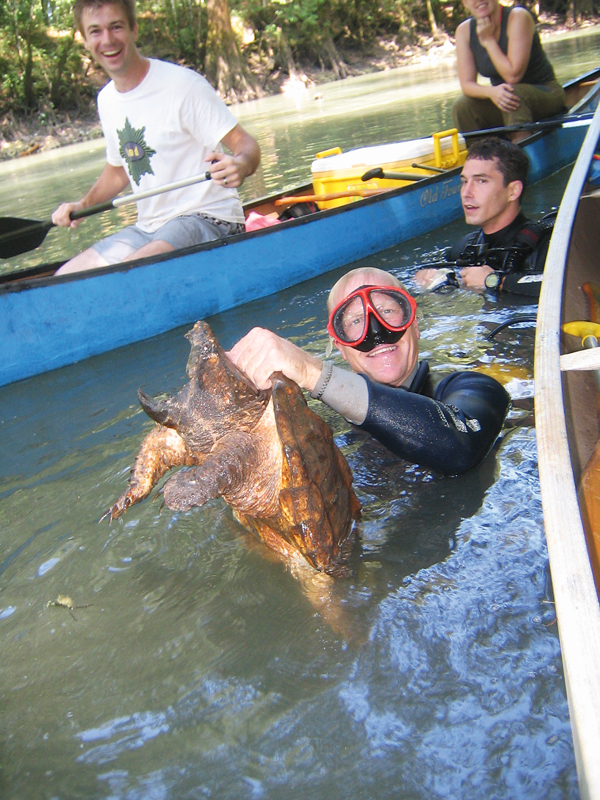
Kurt Buhlman
The author with the first alligator snapping turtle he captured.
Alligator snapping turtles rarely bask and nearly never emerge onto land, except for nesting females, and even they nest very close to the river’s edge. Thus, not surprisingly, genetic technology can now identify most alligator snapping turtles to their river of origin. This information can be very useful for future conservation and reintroduction programs, as alligator snapping turtle populations declined substantially from the 1960s to the 1990s, when many were trapped for the commercial soup trade. Even today, large numbers of them, including hatchlings, are being exported to China. Individuals are still subject to harvest or they simply drown on trotlines set primarily for catfish.
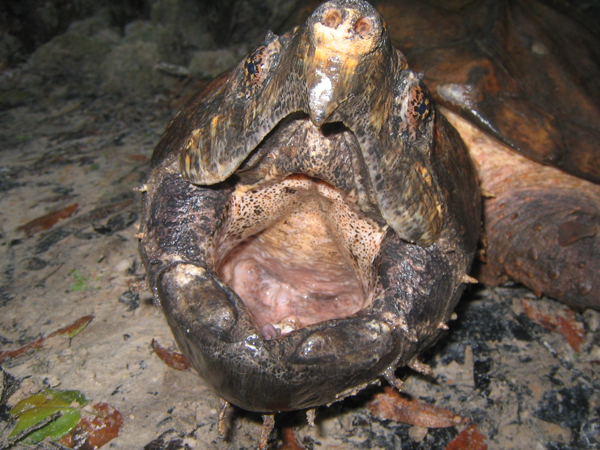
Kurt Buhlman
The jaws of an alligator snapper are designed to crush mussels, and you really don’t want to be bitten by them.
As all turtle biologists understand, the commercial harvest of adult turtles is not a sustainable venture, and although alligator snappers do appear to be recovering in a number of rivers throughout their range, the species remains vulnerable. Due to the life history of this long-lived, slow-to-mature turtle, full recovery to former population sizes is predicted to take a long time.
The Problems Snappers Face
In general, snapping turtles of both species are rather invulnerable to most predators, except humans and automobiles. However, there are instances of predation on adults and subadults by river otter. Ron Brooks and colleagues reported that river otter killed a number of hibernating common snappers under the winter ice in Ontario, whereas Day Ligon and colleagues have more recently documented mortality of juvenile head-started alligator snappers by otter.
Snapper nests and eggs are actively sought out by raccoons, which are believed to be much more abundant now than historically, as well as fox and skunks, and hatchlings may be eaten by other various predators. As a kid, I found a hatchling common snapper and put it in an aquarium that also housed a bullfrog. I enjoyed showing the turtle off to my friends, until the next day when I found the snapper gone. I remember confronting each of my friends and asking where the snapper was, and only years later did I realize it was still in the aquarium, but inside the bullfrog.
Snapping turtles have a reputation among fishermen and waterfowl hunters as being a problem. I would argue strongly that snapping turtles are a threat to populations of neither. Although a common snapper may occasionally grab an unsuspecting duckling, the taking of game fish, such as sunfish and bass, does not happen. Snappers are wonderful pond scavengers and garbage collectors that will eat any dead fish they come upon, but they cannot capture live, healthy sunfishes.
Common snappers eat a lot of aquatic plant material, as well, such as Elodea, and they will also eat bullfrogs and crayfish. Alligator snappers possess a worm-like tongue and talented luring abilities. This tactic seems to be most frequently employed by hatchlings and juvenile alligator snappers, which are poor swimmers and vulnerable to riverine predators. Thus, they probably remain hidden and lure small minnows and darters.
Adults appear to scavenge predominately on dead fish, as well as dead mammal carrion, such as muskrats. Crayfish and freshwater mussels make up a large part of the adult diet, but surprisingly so do nuts such as acorns. Alligator snappers also have an appetite for musk turtles (Sternotherus carinatus, S. odoratus and S. minor).
Avoiding Snapping Turtle Bites
I have been fascinated by snapping turtle since I was 12 years old and grabbed the tail of my first common snapper as it paddled by me in a New Jersey lake. Why I decided to grab its tail and pull it to the water’s edge, I don’t know, but it wasn’t a bad catch for a 60-pound kid.
I put the turtle head-first into the front wire basket of my bicycle and rode home. My siblings and I watched the turtle in a plastic play pool for the afternoon, until my dad and I took it back to the lake and let it go. I wanted to see more of them, though, and after that, I took to paddling a small rowboat around the edges of the lake in the evening, when I would often see large snappers moving around underwater at the edges of the lily pads and the drop-off to deeper water. The magnification effect of the water, plus the fact that I was a small kid, always made those snappers look big and spooky, but fascinating nevertheless.
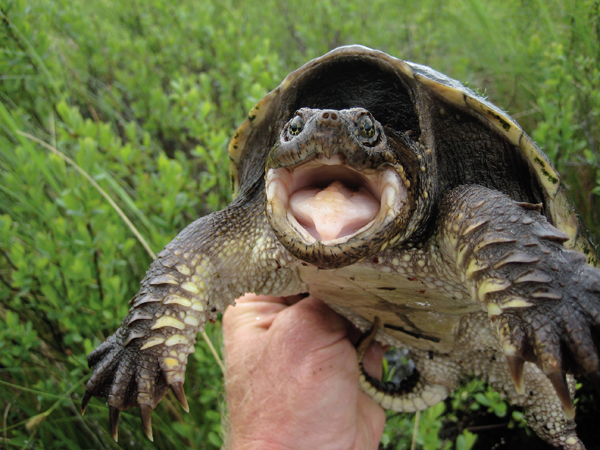
kurt buhlman
Snapping turtles have powerful jaws.
Snapping turtles need to be handled with caution and respect. They can bite and bite fast! The correct way to pick up a large common snapper is to get behind it—which can be difficult, because they like to turn around and face off with you—and grab it by the tail and slightly lift the turtle just enough so that its rear legs lose contact with the ground. As the rear legs sweep backward and from behind the turtle, grab one leg directly in front of the claws, drop the tail, and then grab the other leg. Now you can lift the large snapper gently off the ground by its legs, with its head hanging downward and facing away from you. Do not hold snappers by the sides of the shell, as their long, flexible necks will allow the head to come looking for the fingers that are holding the turtle.
Although you can get control of a large snapper by grabbing its tail, never lift it off the ground by just the tail. This can dislocate the turtle’s vertebrae. Snappers are not designed to hang by their tails, like an opossum.
For some reason, hatchling common snappers rarely try to bite. Once they reach 3 inches or so, that changes. However, hatchling alligator snappers always seem willing to take you on.
My first experience with alligator snappers did not occur until only a few years ago. I had the wonderful opportunity to participate in an alligator snapper survey coordinated by the Georgia Department of Natural Resources on a beautiful cypress-lined stream, with clear water and limestone outcrops. All we had to do was paddle canoes and look for alligator snappers on the bottom, sometimes as deep as 10 feet. As I paddled my canoe and passed over the underwater limestone ledges, I fleetingly saw what made me think of a white soccer ball. As I drifted past, I suddenly realized that the “white ball” was the head of an enormous alligator snapper sitting on the bottom among the rocks. (The head of old alligator snappers will often turn white or yellowish). The next second, my mask was on my face and flipped out of my canoe and swam down to where that snapper lay. Other members of the crew measured and marked him for future recapture studies; he weighed 93 pounds.
Should You Keep a Snapping Turtle as a Pet?
The first consideration in keeping any snapping turtle is its eventual size. Big snappers require a lot of space and need to be kept singly as they quickly get aggressive with each other. I have kept hatchling common snappers together immediately after hatching with no problems, but never for more than the first few months of life. So before you run out and get a hatchling from a reputable dealer, consider that it will become large. Snapping turtles are often found in urban park ponds, likely because they grew so large and possibly with a sour disposition that their owners decided to release them.
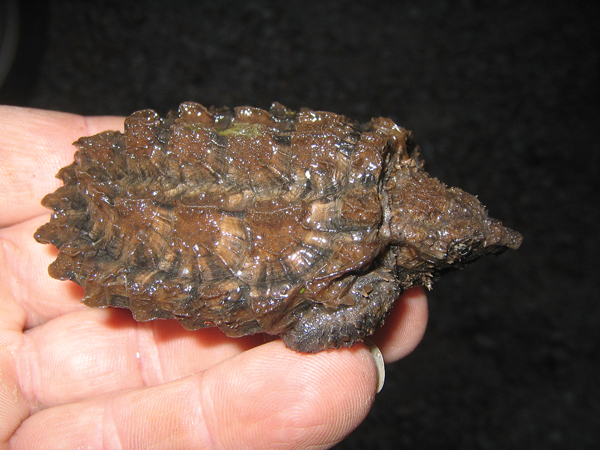
Kurt Buhlman
The first consideration in keeping any snapping turtle is its eventual size.
Hatchling snappers generally do well in captivity. They will eagerly accept a variety of foods, including prepared pellets such as Reptomin and Mazuri, along with earthworms, chopped fish and beef, and salad shrimp. They grow quickly, and for the turtle fancier who is well-prepared and committed to taking on the responsibility, and who understands the safety requirements for both the keeper and kept, snapping turtles are fascinating to keep.
Common snapping turtles are hardy and not picky about temperature requirements, although they should be kept in temps between 75 and 85 degrees Fahrenheit. Hatchlings can be kept in a 10-gallon aquarium with a gravel bottom and a basking site, such as a flat rock, that will allow the turtle to completely emerge from the water. Common snappers will bask in captivity, like other turtles. In the wild, they can be seen on basking logs with other turtles, particularly in the early spring when the water is cold. Later in the year, they bask by lying in warm, shallow water, so a pet snapper may prefer to bask where the beam from the 50-watt, full-spectrum bulb you should have over the enclosure hits the water.
Whether you’re keeping a hatchling or adult snapper, it’s important to make its water depth no more than what’s necessary to allow the turtle to sit comfortably on the bottom and reach its head to the surface. As aquatic as snappers are, they will tire out and drown if they are forced to swim at the surface in order to breathe.
Snapping turtles are also incredible climbers. Not only are they strong, they have thick, long claws that can hook onto most anything. And their long tails can help them push up and provide extra vertical height. So be sure their enclosures are escape-proof.
A glass aquarium works fine for a hatchling up to 4 inches in carapace length. Plastic tubs, such as those made by Rubbermaid, work well for larger snappers. Stock tanks, too, can house a single snapper depending on size. Common stock tank dimensions are as follows: 50 gallons = 52 inches long by 31 wide and 24 tall; 150 gallons = 58 inches long, 39 wide and 24 tall; and 300 gallons = 63 inches long, 69 wide and 25 tall.
The 50 and 150-gallon tanks are oval in shape, and the 300 gallon is nearly round. A wire mesh lid with a strong wood frame is recommended for stock tanks, to keep turtles in and unwanted mammals out. A locking lid will also prevent neighborhood children from reaching inside.
Some stock tanks can be ordered with screw-in bulkheads that allow for easy draining of the tanks. Submersible pumps, such as a Fluval 3, work well for hatchling aquariums, but such filters are likely to be dislocated and rolled around a tub by a large snapper. Filtration of a stock tank containing a large snapper can be achieved with an external canister filter.
If you choose to keep a snapper in a backyard pond, then the fencing around that pond should be constructed of grip-free material. Wire mesh fencing will not work, as snappers will climb it. I have surrounded backyard ponds with aluminum roofing flashing. This needs to be back-supported with a strong hog-wire or other garden fencing to prevent the flashing from being pushed over by a large snapper. I recommend the flashing be 36 inches tall to prevent escapes. True Value Hardware sells a heavy-gauge roofing flashing that is already painted brown, tan, or green, which is visually appealing and blends with the scenery around an outdoor pond.
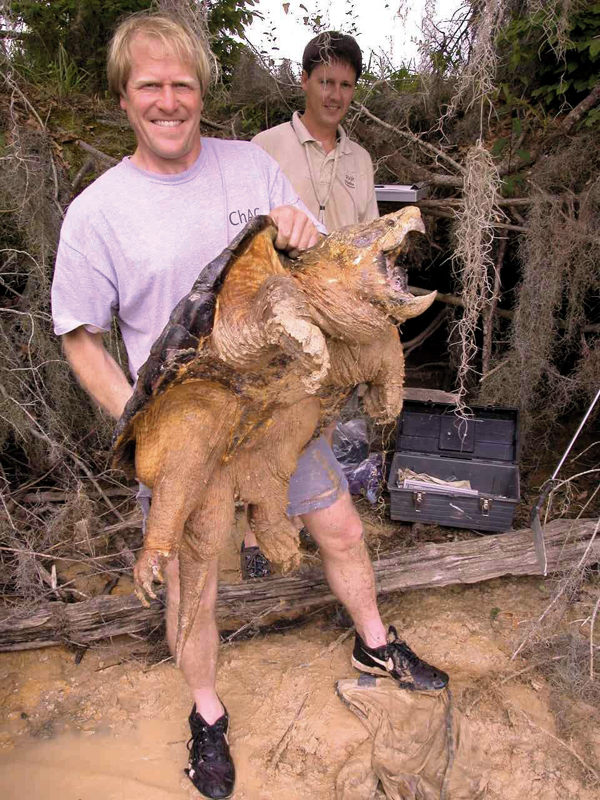
Kurt Buhlmann
The author with a disgruntled alligator snapper. Macrochelys temminckii is one of the world’s heaviest turtles, with record weights in the 300-pound range.
In general, alligator snappers are shy compared to common snappers, and rarely, if ever bask, but full-spectrum and UV lighting should still be placed over their enclosures. Remember, too, that alligator snappers are solely river dwellers that prefer moving water. Whereas a common snapper is happy in a duckweed-covered, muck-bottomed pond, alligator snappers like clear, or tannin-stained, water without particulates, and a sand or gravel bottom. Water quality is much more important for alligator snappers, and their enclosures demand filtration or frequent water changes, with a pump that keeps their water circulating. The water temperature should be near a near-constant 80 degrees, and pH should be kept near 7.0. Sunken logs will provide cover for these shy animals to hide, but be sure that logs or other décor cannot trap and drown the turtle.
As with nearly all turtles, properly caring for snappers is a long-term commitment. Again, you must be sure that you will be able to provide the space that their enclosures will require. Of course, if you are unable to do so, there is no reason that you cannot plan your own field trip, and visit with and observe snappers in their natural environment, as I have often been fortunate to do.
Kurt Buhlmann is a senior research associate and conservation ecologist at the University of Georgia’s Savannah River Ecology Laboratory. His research focuses on applied conservation solutions for reptiles and amphibians, including habitat restoration and management, reintroductions and population augmentations, and head-starting projects, particularly with turtles. He has a Ph.D in ecology from the University of Georgia, an MS in wildlife management from Virginia Tech and a BS in environmental studies from Stockton State College (NJ).


